A classic Thai dish, Goong Ob Woonsen (Thai shrimp and glass noodles) is famous for its unique, memorable flavors. It is known for its delicious taste, texture and healthy ingredients, using large tender shrimp, delicate glass noodles, and a medley of fresh ingredients infused with savory umami Thai sauces. It's ready to enjoy in less than 30 minutes!
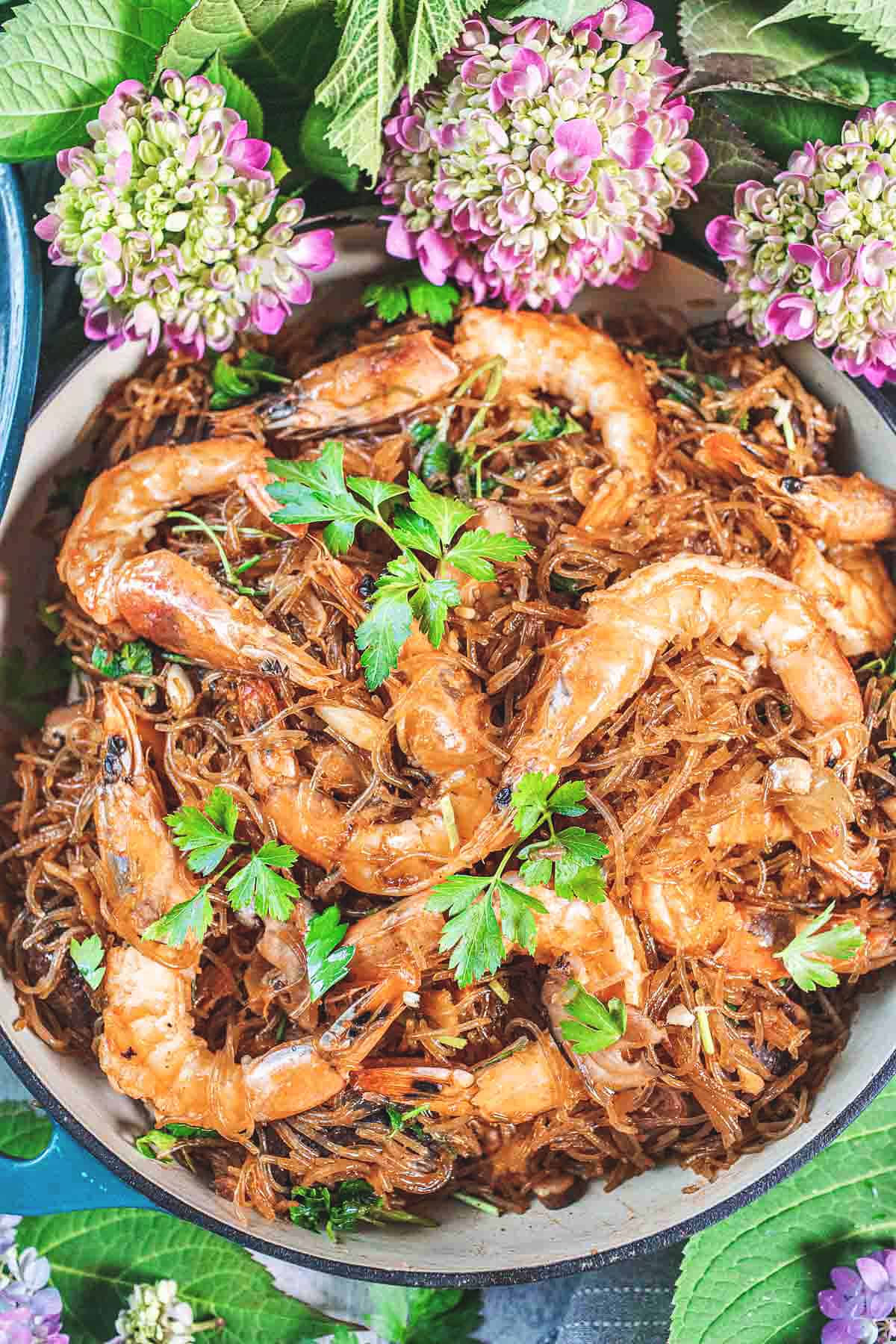
If you love glass noodles, don't forget to try Pad Woonsen, a popular Thai stir-fried dish made with woonsen noodles. For a tasty soup recipe with glass noodles, try Gaeng Jeud Woonsen, a delicious Thai soup with ground pork and soft tofu.
Read more about the different types of Thai rice noodles here.
Jump to:
- Why You'll Love This Woonsen Noodles Recipe
- What is Goong Ob Woonsen?
- Traditional goong ob woonsen
- Ingredients for Thai Shrimp and Glass Noodles
- How To Make Goong Ob Woonsen
- Garnishing Options
- Helpful Kitchen Notes and Tips
- Helpful Kitchen Tools for This Recipe
- What to Serve With Shrimp Noodle Clay Pot Goong Ob Woonsen
- Variations & Substitutes
- Storing Leftovers
- Frequently Asked Questions
- More Thai Recipes You'll Enjoy
- Goong Ob Woonsen (Thai Shrimp and Glass Noodles)
- More Thai Noodle Recipes
Goong Ob Woonsen (กุ้งอบวุ้นเส้) is beloved by Thai people in all regions of Thailand as it is a very flavorful dish and can be easily customized to different flavors and taste buds.
It is an iconic dish of Thai seafood restaurants, especially in the South of Thailand, where the ocean and sea surround it, and seafood is abundant and are extremely popular.
Prepare for an unforgettable Thai culinary adventure that will make your taste buds sing!
Why You'll Love This Woonsen Noodles Recipe
- A Burst of Unique Flavors: Goong Ob Woonsen offers a mesmerizing interplay of sweet and savory flavors, accentuated by fragrant herbs and a hint of spice.
- Health Benefits: It features fresh ingredients and aromatic herbs, like ginger, garlic, cilantro stems, and parsley. This dish satisfies your cravings and provides a healthy dose of goodness.
- Easy Preparation: My step-by-step guide with photos will make it a breeze to whip up this Thai delicacy in your kitchen.
- Aromatic Delight: The aroma of the herbs and spices will transport you to the vibrant streets of Thailand, making this dish a feast for all your senses.
What is Goong Ob Woonsen?
Goong Ob Woonsen, also known as Thai Glass Noodles with Shrimp, is a traditional Thai dish showcasing Chinese cuisine's influence on Thai culinary traditions. It features plump shrimp, mung bean noodles, and an assortment of fresh herbs and vegetables cooked in a clay pot.
The dish is brought to life with a savory blend of sauces, including soy sauce, oyster sauce, and a splash of sweet soy sauce, creating a memorable umami flavor profile.
Here's a short Thai lesson for you. In Thai, Goong means Shrimp, and Ob means to cover up (food in this case) in steam or smoke to cook. And Woonsen means glass noodles.
Traditional goong ob woonsen
Woonsen means glass noodles. In the traditional way of making Goong Ob Woonsen, this recipe is cooked in a clay pot with a lid. In modern Thai cooking, in Thailand, restaurants and home kitchens, clay pot cooking is not so commonly used anymore.
Clay pots are a bit finicky to work with, and if not used properly, they can easily crack, break, and get destroyed in the cooking process—a big mess.
For many Thai people, the traditional way of using smashed herbs to infuse the flavors is by placing the large ginger slices, coriander roots, and large cloves of garlic in the bottom of the pot before adding the rest of the ingredients.
Those large herb pieces are either picked out before serving, or they don't get eaten when served. I find this bothersome. LOL. Why would I waste such flavorful and healthy herbs?
To be fair, I truly think the clay pot couldn't handle the sauteeing of aromatics in high heat without cracking or breaking. Charcoal was typically used to make this one, at least with my Thai family.
Since my recipe doesn't use a clay pot, I'm slicing my aromatics into smaller, ingestible pieces. And I want to extract the extra flavors! It's all about the little extra flavors that add up to one big impressive flavor in each bite in as many of my recipes as I possibly can!
Ingredients for Thai Shrimp and Glass Noodles
These are the essential ingredients for making authentic Thai shrimp and glass noodles Goong Ob Woon Sen Recipe.
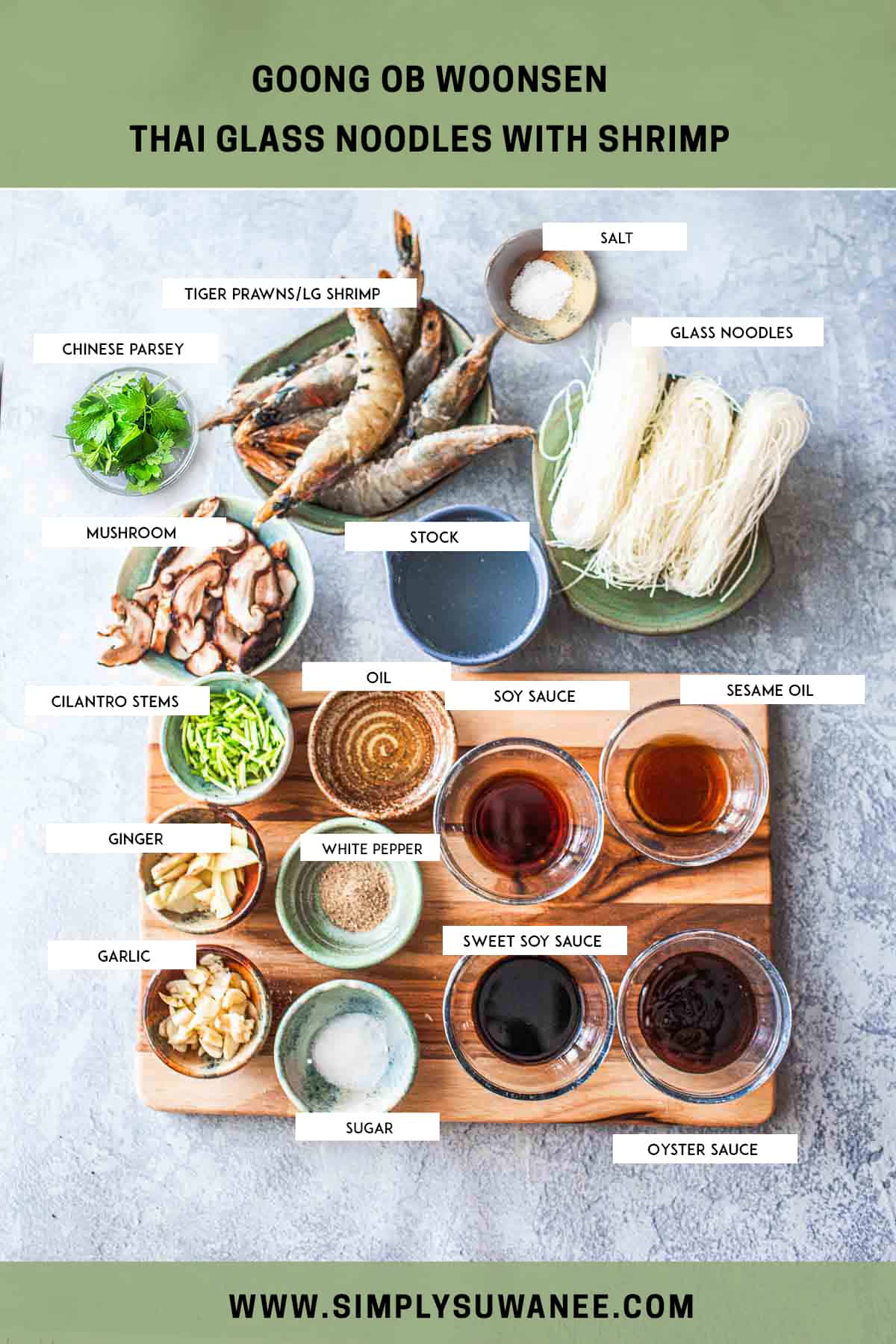
- Glass noodles. They are also called bean thread, mung bean, or silver noodles. Read more about glass noodles and other types of Thai noodles here.
- Large shrimp or tiger prawns. Find the largest shrimp you find for this recipe. Shells are removed from the body but leave tails and heads on. We will maximize the orange creamy part in the head of the shrimp to intensify the flavors of this Goong Ob Woonsen. Use regular shrimp if large tiger prawns aren't available.
- Shitake mushrooms. Portobello is fine for substitutes.
- Ginger, sliced thin and long.
- Garlic, thinly sliced
- Cilantro stems. If you can find cilantro roots, use 4 roots and chop them into very small pieces before cooking.
- Chinese or Italian parsley, chopped into 1 ½ inch pieces. Use the tender, leafy parts of celery as a substitute.
- Unsalted chicken stock or broth. I used homemade unsalted chicken stock for my recipes. Water is fine, too, but you may need to adjust the flavors at the end with more soy sauce or oyster sauce.
- Cooking oil. Use avocado, vegetable, or canola oil.
- Oyster sauce. The umami silky, savory sauce. Don't skip this one.
- Light soy sauce. Regular soy sauce is fine, too.
- Sweet soy sauce. Dark soy sauce can be used, but add 1 tablespoon of honey per serving.
- Sesame oil. This is where the Chinese influence comes in—using sesame oil to add an extra depth of flavor and aroma.
- Sugar and Salt. It helps add a contrasty balance to the dish.
- Ground white pepper. Add more if you prefer a little heat in your Ob Woonsen.
- Optional ingredients are green onions, A few cilantro stems, and the leafy parts for garnishes.
How To Make Goong Ob Woonsen
Step 1: Soak Glass Noodles. Begin by soaking the delicate glass noodles (bean thread noodles) in warm water or according to package instructions. Drain noodles and loosely cut to 6-8 inches in length and set aside.
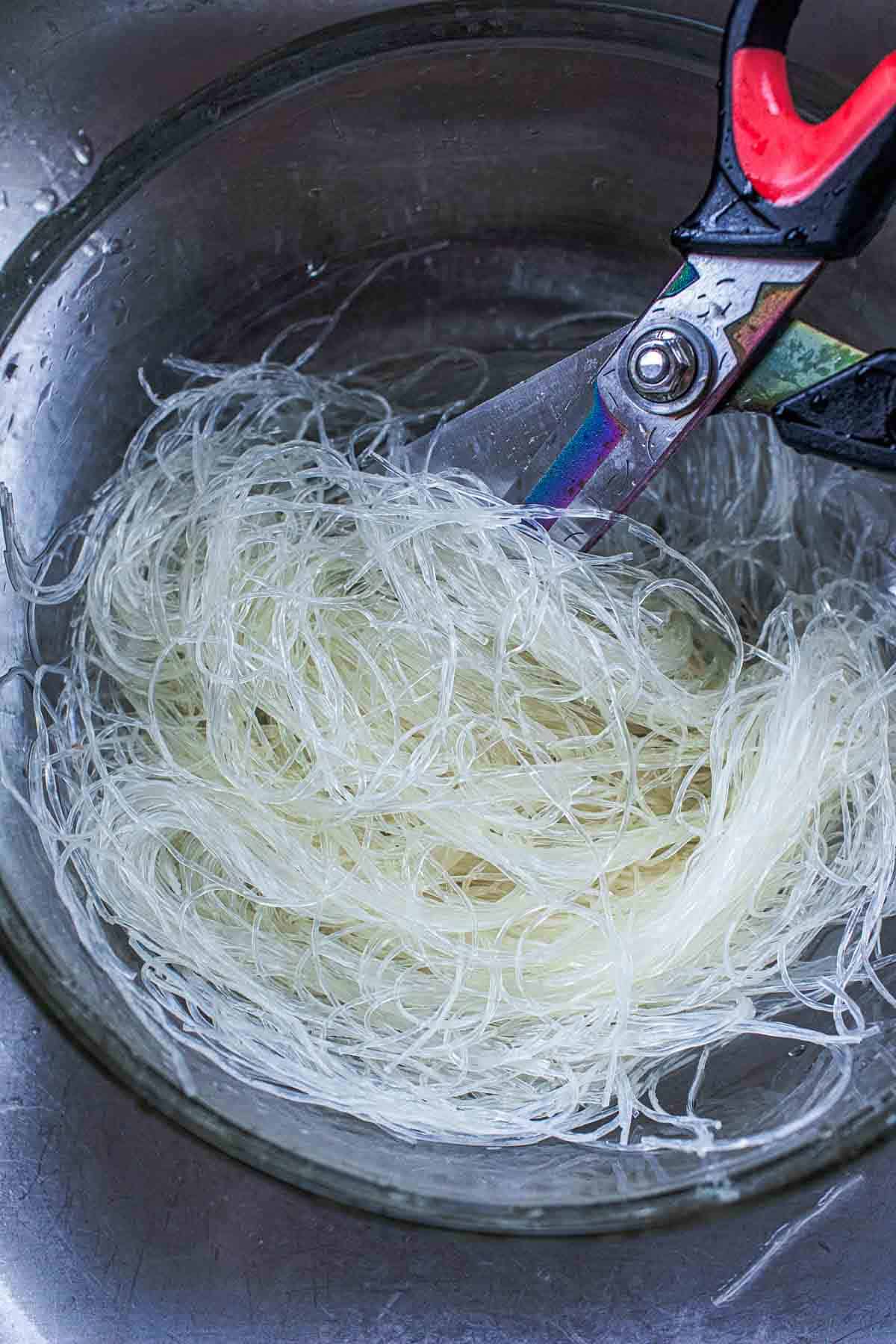
Step 2: Make the sauce. Add the oyster sauce, sweet sauce, light soy sauce, sesame oil, sugar, salt, and white pepper in a small bowl. Mix well and set aside.

Step 3: Prepare the shrimp. Wash and trim the claws, whiskers, and the sharp, pointy end at the top of the shrimps. Peel the shells on the body of the prawns, leaving the heads and tails intact.
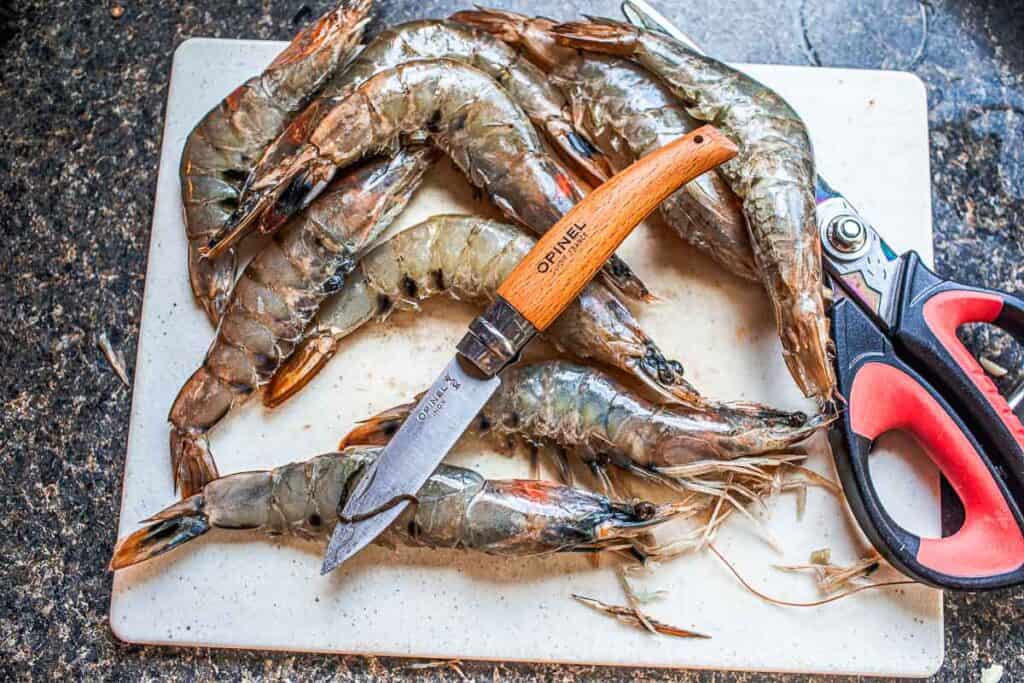
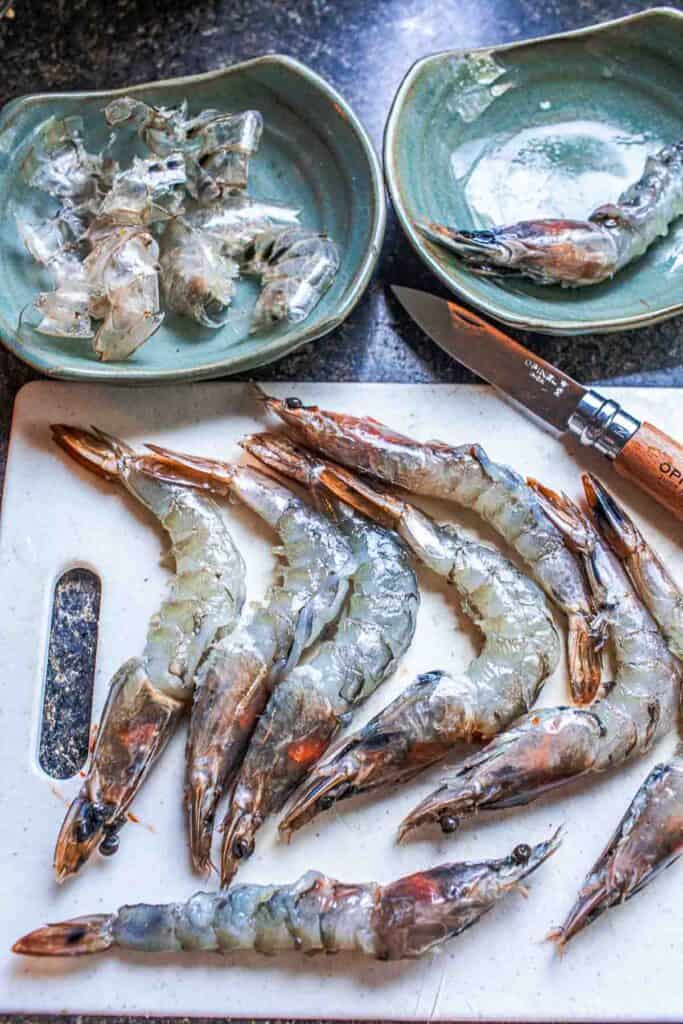
The heads of the large prawns or shrimp have a naturally creamy sauce-like texture that adds a burst of umami flavor. Slice through the back of the shrimp shell with a small paring knife and remove the veins. Set aside.
Step 4: Prepare the aromatics. Slice the herbs, garlic, ginger, and cilantro roots. These will be your secret weapon for infusing the flavors.
At medium-high heat, Heat the cooking oil and Sautéed the Aromatics In a heavy-bottomed pot over medium heat.
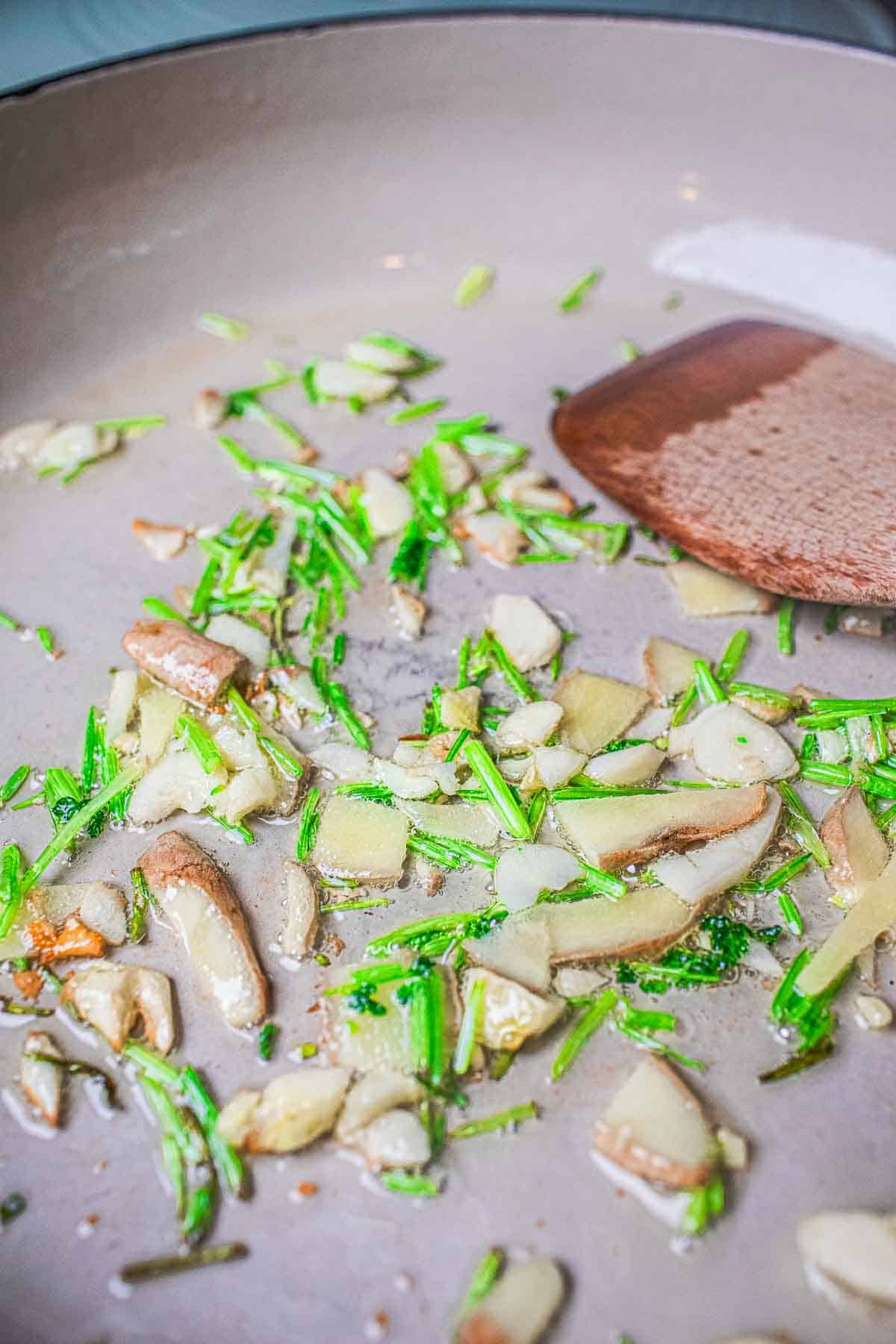
Stir-fry until the aromatics release their fragrance. 1-2 minutes.
Step 5: Add glass noodles. Lower the heat to medium. Add the glass noodles and the soy sauce mixtures and quickly stir until the glass noodles are evenly covered in the golden brown sauce.
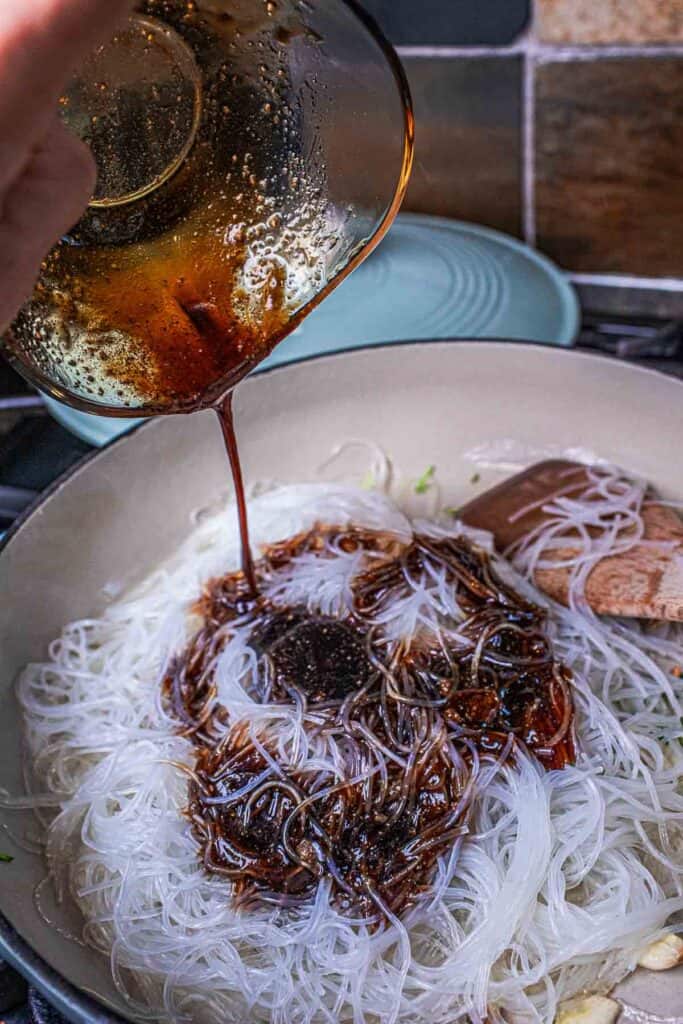
Step 6: Add the mushroom and shrimp by stacking them evenly on the glass noodles. Then, pour the stock evenly over the pan. Do not stir. Cover the pan with a lid and allow the dish to "Ob" or steam using condensation to help infuse all the flavors together.
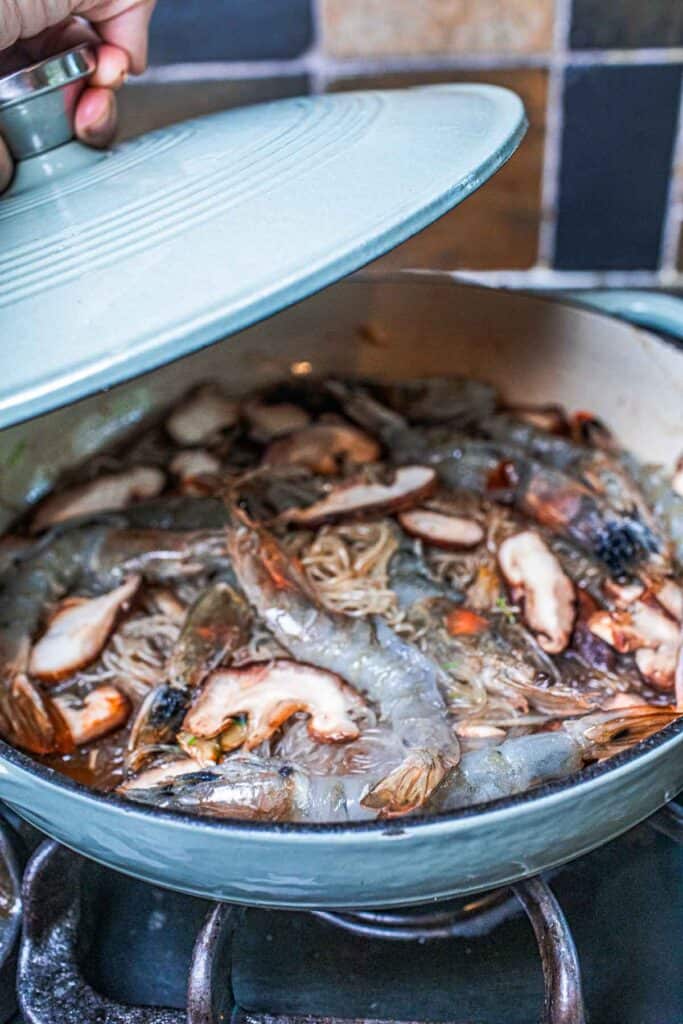
Leave it for about 5 minutes or until the shrimp is cooked. Larger shrimp will take longer. Watch for the pinkness of the shrimp. That's when you know it's done.
Step 7: Open the lid and gently stir the whole thing together, trying not to break the shrimp, especially the top of the head. They are tender once cooked.
If your pan is very dry, add a splash of water or stock to help loosen it up.
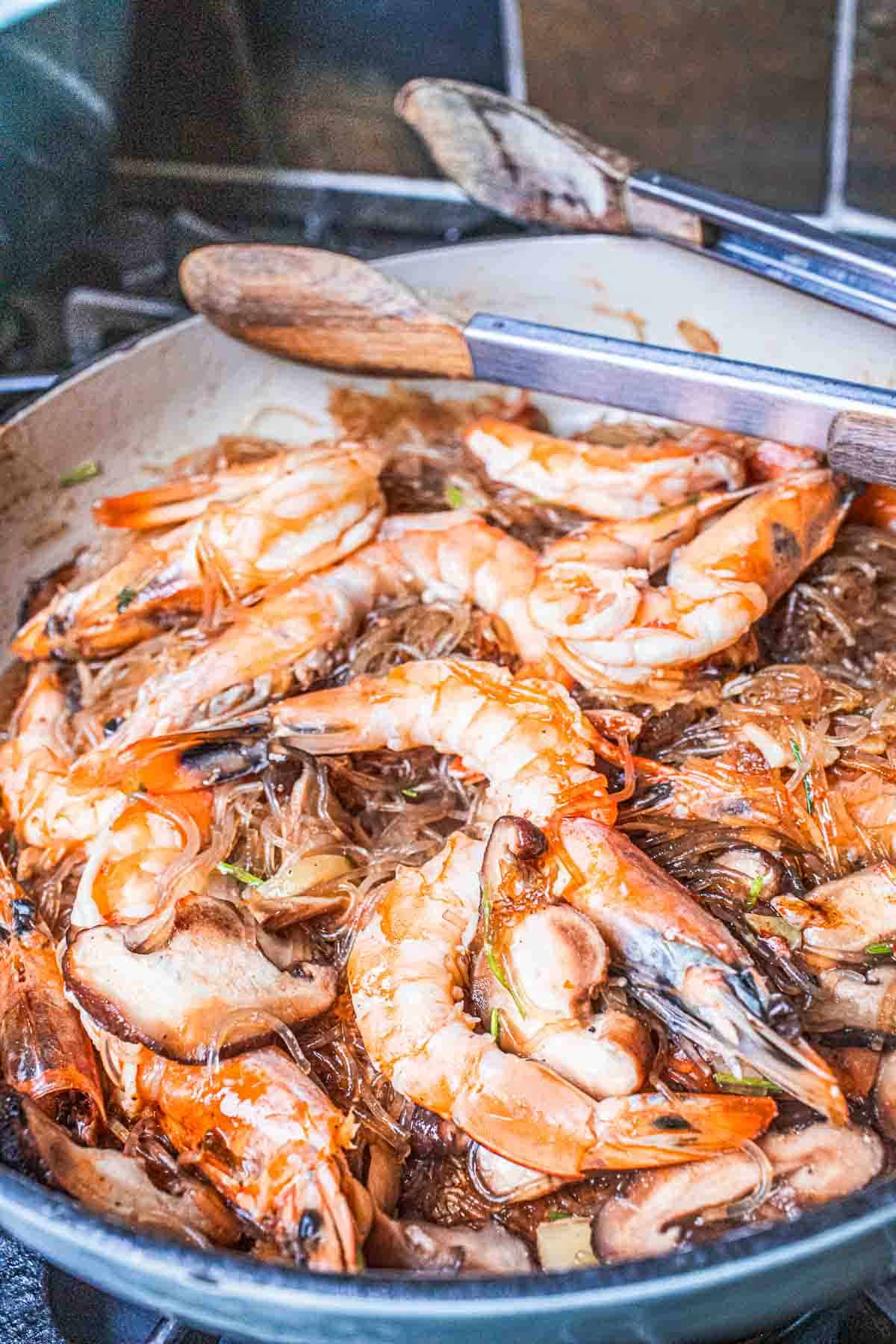
Step 8: Add parsley. The only thing left at this step is to add the Chinese parsley or, if preferred, add sliced spring onions, cover, and cook for 1 more minute until wilted.
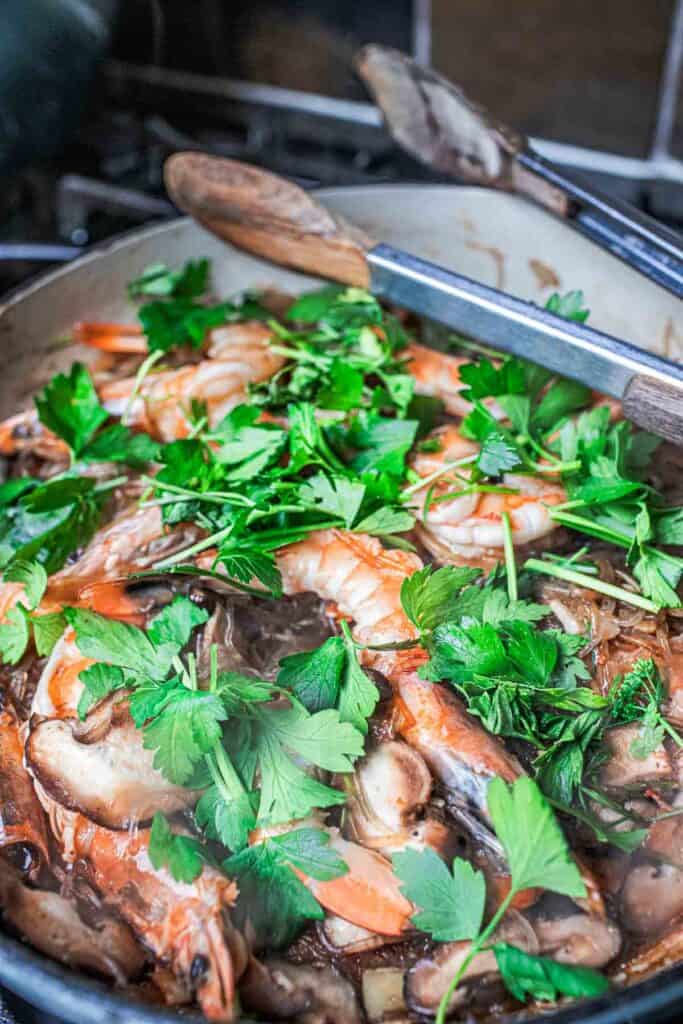
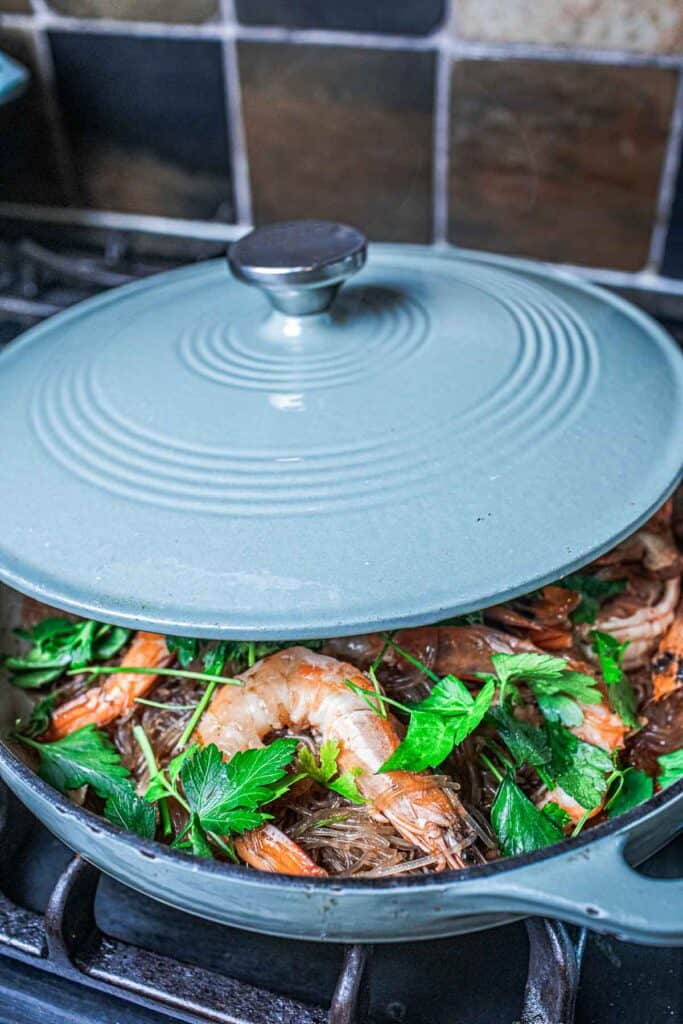
Turn the heat off, open the lid, and gently stir everything together. DONE!
Garnishing Options
Before serving, garnish your Goong Ob Woonsen with fresh cilantro stems, parley, chopped green onion, and a sprinkling of ground white or black peppercorns. The vibrant colors and fragrant herbs will take your dish to the next level.
Helpful Kitchen Notes and Tips
- For my recipe, you can use any large skillet; a non-stick or cast iron skillet will work. I used my cast iron skillet, and it worked out perfectly well.
- For glass noodles. I often use warm or hot water (not boiling) to soak mine to help speed up the process. Watch for when the noodles are soft and pliable, and you are set.
- Read the packet instructions for soaking glass noodles, as many suggest soaking them at room temperature.
- Don't overcook the shrimp; they should be plump and tender.
- Adjust the level of spice by adding more or less white pepper.
- Add bok choy, shredded carrot, kale, or baby corn if you feel adventurous or need more veggies.
- A clay pot enhances the presentation like the traditional Thai style, but you can use a heavy-bottomed pot as an alternative.
Helpful Kitchen Tools for This Recipe
- To prepare Goong Ob Woonsen, you'll need a heavy-bottomed pot with a tight-fitting lid or a clay pot for an authentic touch. A sharp knife and pointy scissors are also essential for deveining and preparing the shrimp.
What to Serve With Shrimp Noodle Clay Pot Goong Ob Woonsen
This Thai glass noodle dish pairs wonderfully with jasmine rice, adding a delightful contrast to the bold flavors. The fluffy rice perfectly complements the rich, saucy shrimp and glass noodles.
Variations & Substitutes
- Lobster, large crab legs, or claws also work great for this recipe!
- Feel free to get creative with your Goong Ob Woonsen recipe. You can experiment with different vegetables, such as baby corn, mushrooms, or bell peppers, to customize the dish.
- If you can't find certain ingredients, such as Chinese celery stalks, you can replace them with regular celery but only use leafy tender parts.
Storing Leftovers
Leftovers can be stored in an airtight container in the refrigerator for 2 days max. The noodles become soggy quickly in the Ob Woon Sen recipe.
For reheating, reheat in a microwave or on the stovetop when ready to enjoy it again.
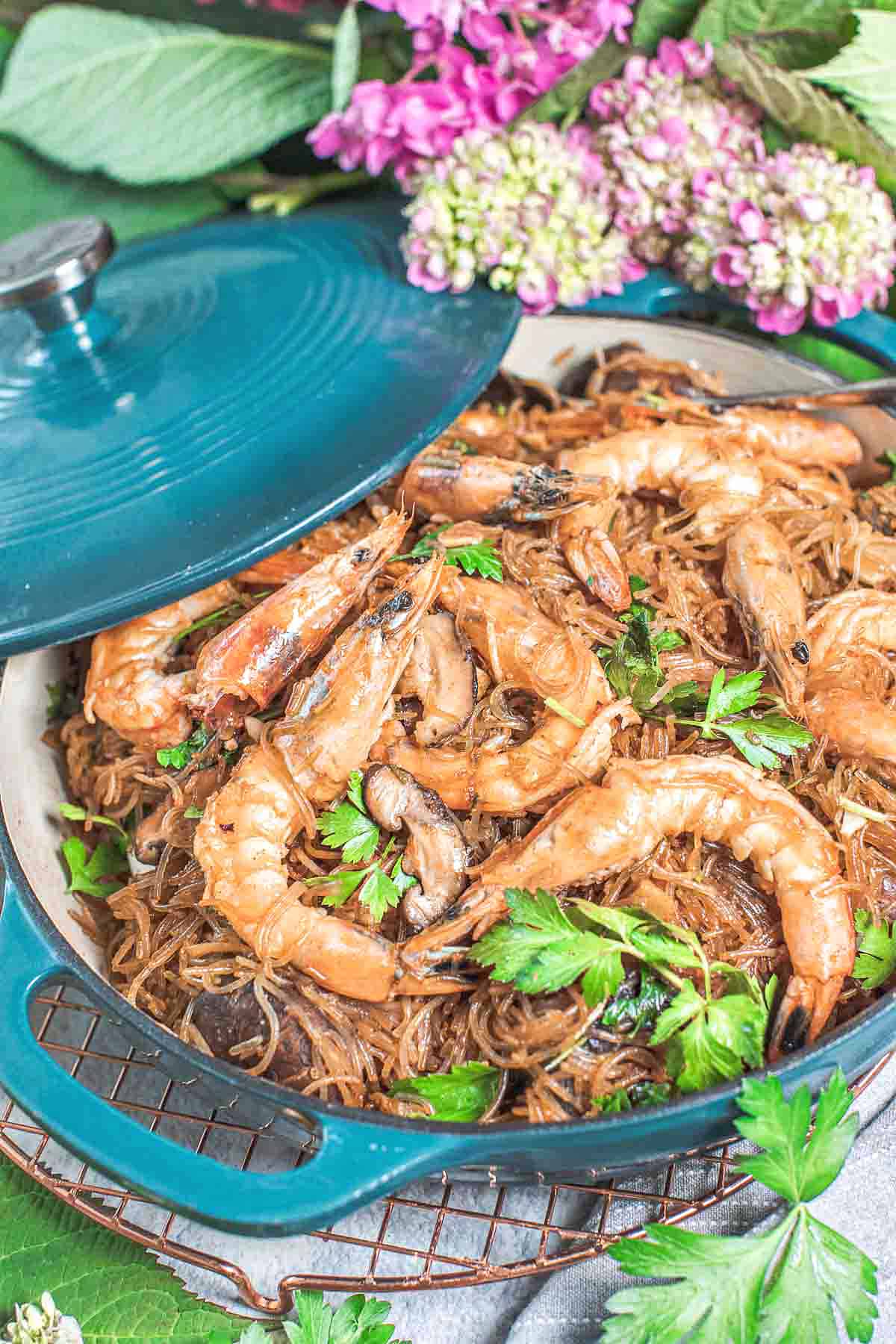
Frequently Asked Questions
Goong Ob Woonsen stands out for its fresh ingredients, delicate glass noodles, and a savory, umami-packed sauce. The use of clay pots and the Chinese influence on Chinese cuisine give it a distinctively modern twist.
Yes, you can. You can control the spice level by adding more or less white pepper, making it suitable for your taste.
You can create a vegetarian version by omitting the prawns and using tofu or an array of vegetables as a delicious alternative.
While best enjoyed fresh, you can make the sauce in advance. The rest of the ingredients and steps are best to prepare it fresh.
Thai glass noodles, cellophane noodles, or bean thread noodles are made from mung bean starch or green bean starch. They are thin, translucent noodles that become soft and slippery when cooked.
They are commonly used in Thai dishes like salads, soups, and stir-fries.
More Thai Recipes You'll Enjoy
- Pad Mee is an easy Thai noodle stir fry with vegetables and savory sauce.
- Thai green seafood sauce is a simple dish made with green chiles, garlic, fish sauce,, and lime juice.
- Thai Yellow curry with pork belly
- Chicken massaman curry with sweet potato
- Prik Nam Pla, a simple dipping sauce with fresh chilis and fish sauce
- Tom Yum Goong is a delicious sour soup and one of the most popular dishes in Thailand.
- Kabocha squash dessert with coconut milk
**Love a recipe you've tried? Please leave a 5-star rating in the recipe card below and a review in the comments section further down the page. Or follow me on Facebook, Pinterest, or Instagram!**
Print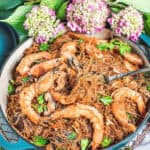
Goong Ob Woonsen (Thai Shrimp and Glass Noodles)
- Total Time: 30 minutes
- Yield: 6
- Diet: Low Lactose
Description
A classic Thai dish, Goong Ob Woonsen (Thai shrimp and glass noodles) is famous for its unique, memorable flavors. It is known for its delicious taste, texture, and healthy ingredients, using large tender shrimp, delicate glass noodles, and a medley of fresh ingredients infused with savory umami Thai sauces. It's ready to enjoy in less than 30 minutes!
Ingredients
- 5 ounces of dried bean thread noodles (mung bean noodles)
- 8-10 oz of large prawns or tiger shrimp, shells, claws, and whiskers removed from the body, leaving tails and heads on.
- 2 tablespoons of cooking oil
- 2 ½ tablespoons slices of ginger, sliced thin and long
- 5 large cloves of garlic, thinly sliced
- 2 ½ tablespoons Cilantro stems. If you can find cilantro roots, use 4 roots and chop them into very small pieces before cooking.
- 3 tablespoons of oyster sauce
- 3 tablespoons of light soy sauce. Regular soy sauce is fine, too.
- 1 tablespoon of sweet soy sauce.
- 1 tablespoon of sesame oil
- 1 teaspoon salt
- 2 teaspoons sugar
- 1 teaspoon of ground white pepper. Add more if you prefer a little heat in your Ob Woonsen.
- 1 cup thinly sliced Shitake mushrooms. Portobello is fine for substitutes
- 1 cup of unsalted chicken stock or broth
- 1 cup of Chinese or Italian parsley, chopped into 1 ½ inch pieces. Use the tender, leafy parts of celery as a substitute.
- Optional ingredients to add: green onions and a few cilantro stems or leaves for garnishing.
Instructions
- Soak Glass Noodles. Begin by soaking the delicate glass noodles (bean thread noodles) in warm water or according to package instructions. Drain noodles and loosely cut to 6-8 inches in length and set aside.
- Make the sauce. Add the oyster sauce, sweet sauce, light soy sauce, sesame oil, sugar, salt, and white pepper in a small bowl. Mix well and set aside.
- Prepare the shrimp. Wash and trim the claws, whiskers, and the sharp, pointy end at the top of the shrimps. Peel the shells on the body of the prawns, leaving the heads and tails intact. The heads of the large prawns or shrimp have a naturally creamy sauce-like texture that adds a burst of umami flavor. Slice through the back of the shrimp shell with a small paring knife and remove the veins. Set aside.
- Prepare the aromatics. Slice the herbs, garlic, ginger, and cilantro roots. These will be your secret weapon for infusing the flavors. At medium-high heat, Heat the cooking oil and Sautéed the Aromatics In a heavy-bottomed pot over medium heat. Stir-fry until the aromatics release their fragrance. 1-2 minutes.
- Add glass noodles. Lower the heat to medium. Add the glass noodles and the soy sauce mixtures and quickly stir until the glass noodles are evenly covered in the golden brown sauce.
- Add the mushroom and shrimp evenly on the glass noodles. Then, pour the stock evenly over the pan. Do not stir. Cover the pan with a lid and allow the dish to "Ob" or steam using condensation to help infuse all the flavors together. Leave it for about 5 minutes or until the shrimp is cooked. Larger shrimp will take longer. Watch for the pinkness of the shrimp. That's when you know it's done.
- Open the lid and gently stir the whole thing together, trying not to break the shrimp, especially the top of the head. They are tender once cooked. If your pan is very dry, add a splash of water or stock to help loosen it up.
- Add parsley. The only thing left at this step is to Add the Chinese parsley or, if preferred, add sliced spring onions, cover, and cook for 1 more minute until wilted. Done!
Notes
- For my recipe, you can use any large skillet; a non-stick or cast iron skillet will work. I used my cast iron skillet, and it worked out perfectly well.
- For glass noodles. I often use warm or hot water (not boiling) to soak mine to help speed up the process. Watch for when the noodles are soft and pliable, and you are set.
- Read the packet instructions for soaking glass noodles, as many suggest soaking them at room temperature.
- Don't overcook the shrimp; they should be plump and tender.
- Adjust the level of spice by adding more or less white pepper.
- Add bok choy, shredded carrot, kale, or baby corn if you feel adventurous or need more veggies.
- A clay pot enhances the presentation like the traditional Thai style, but you can use a heavy-bottomed pot as an alternative.
** Thank you so much for visiting my blog! This is truly a passion for me. If you have enjoyed these recipes and appreciate the hard work I put into them, I would love it if you would share them with your friends! Your recommendation is the highest review I could hope for, and I’d appreciate it! **
- Prep Time: 20
- Cook Time: 10
- Category: Shrimp recipes
- Method: Stovetop
- Cuisine: Thai
More Thai Noodle Recipes
Looking for other recipes like this? Try these:

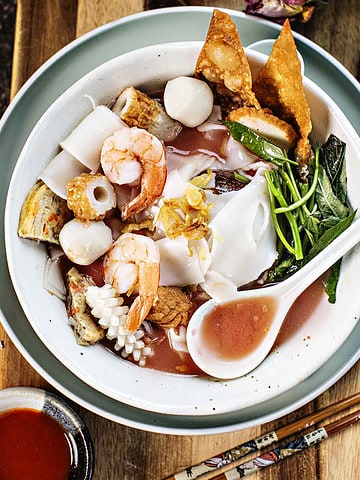
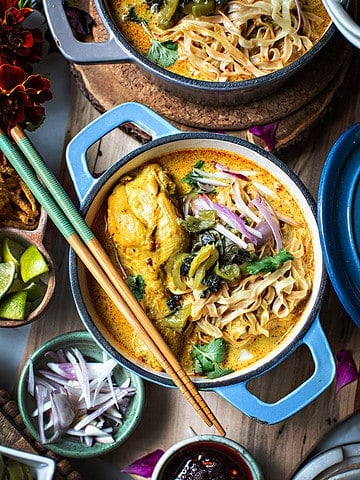
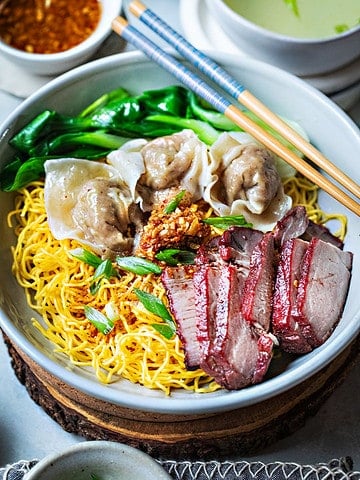
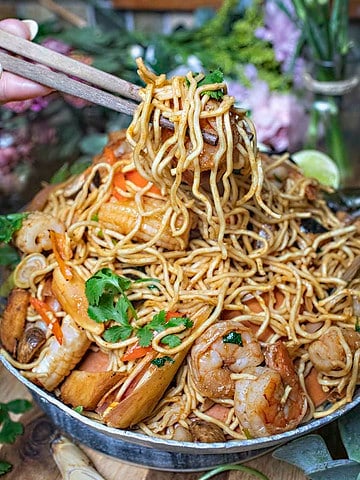
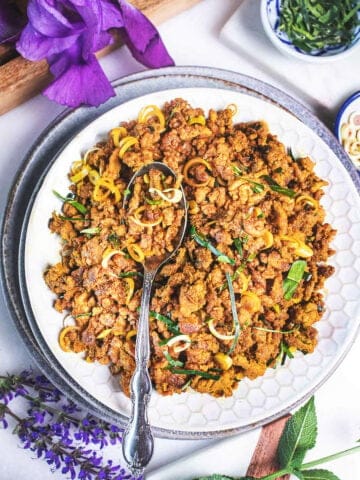
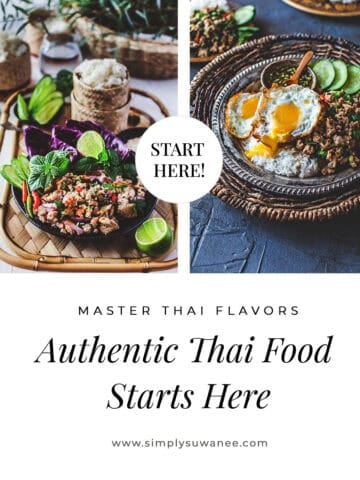

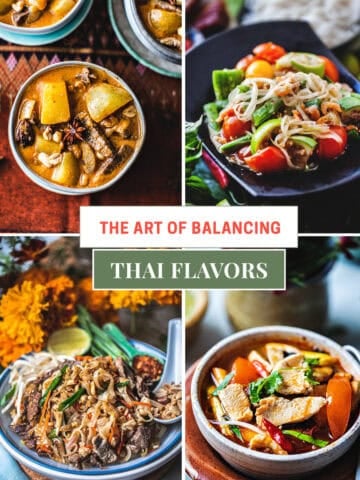
Suwanee says
I'm so glad it turned out so well! Enjoy!
Chan says
So delicious and so easy to make! I have most of the ingredients on hand so was able to made it for dinner and it turned out great.